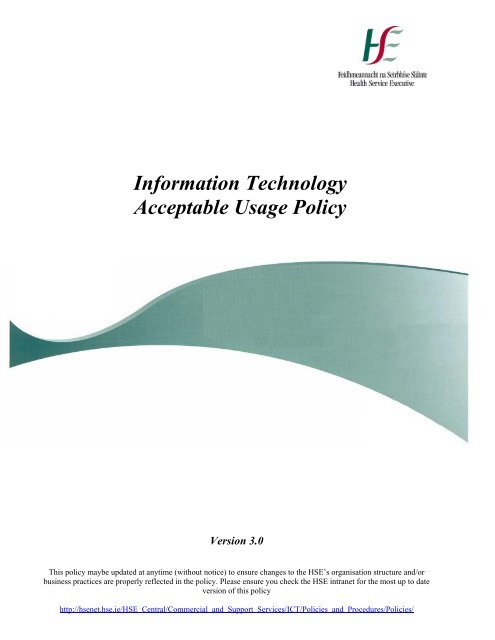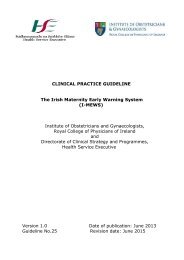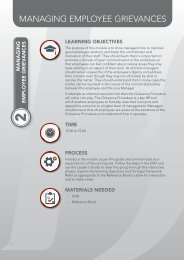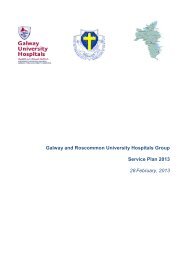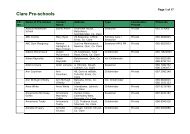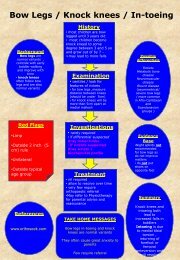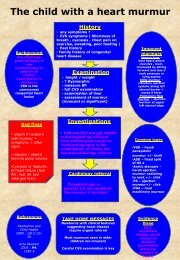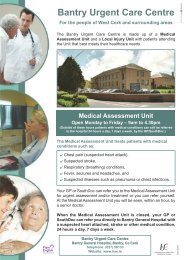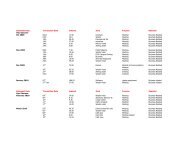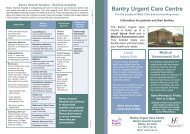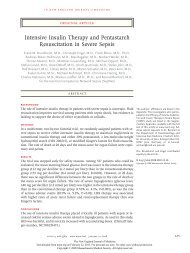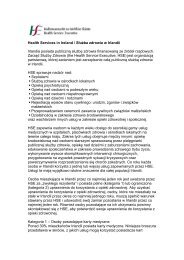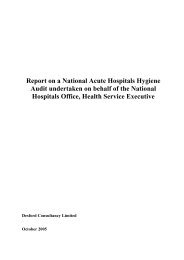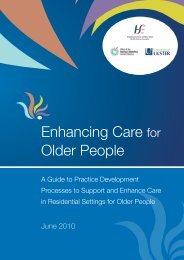I.T. Acceptable Use Policy - Health Service Executive
I.T. Acceptable Use Policy - Health Service Executive
I.T. Acceptable Use Policy - Health Service Executive
You also want an ePaper? Increase the reach of your titles
YUMPU automatically turns print PDFs into web optimized ePapers that Google loves.
Information Technology<br />
<strong>Acceptable</strong> Usage <strong>Policy</strong><br />
Version 3.0<br />
This policy maybe updated at anytime (without notice) to ensure changes to the HSE’s organisation structure and/or<br />
business practices are properly reflected in the policy. Please ensure you check the HSE intranet for the most up to date<br />
version of this policy<br />
http://hsenet.hse.ie/HSE_Central/Commercial_and_Support_<strong>Service</strong>s/ICT/Policies_and_Procedures/Policies/
<strong>Health</strong> <strong>Service</strong> <strong>Executive</strong><br />
Information Technology <strong>Acceptable</strong> <strong>Use</strong> <strong>Policy</strong><br />
Reader Information<br />
Title:<br />
HSE Information Technology <strong>Acceptable</strong> <strong>Use</strong> <strong>Policy</strong>.<br />
Purpose:<br />
Author:<br />
To provide clear guidance on the appropriate, safe and<br />
legal way in which to use the HSE’s Information<br />
Technology resources.<br />
Information Security Project Board (ISPB) on behalf of<br />
the HSE.<br />
Publication date: February 2013<br />
Target Audience:<br />
Superseded Documents:<br />
All users (including HSE staff, students, contractors, subcontractors,<br />
agency staff and authorized third party<br />
commercial service providers) of the HSE’s I.T.<br />
resources.<br />
All local Information Technology <strong>Acceptable</strong> <strong>Use</strong><br />
Policies and Procedures.<br />
Related Documents:<br />
HSE Information Security <strong>Policy</strong>.<br />
HSE Electronic Communications <strong>Policy</strong>.<br />
HSE Password Standards <strong>Policy</strong>.<br />
HSE Encryption <strong>Policy</strong>.<br />
HSE Mobile Phone Device <strong>Policy</strong>.<br />
HSE Access Control <strong>Policy</strong>.<br />
HSE <strong>Service</strong> Provider Confidentiality Agreement.<br />
HSE Information Classification & Handling <strong>Policy</strong><br />
Review Date: February 2014<br />
Contact Details:<br />
Chris Meehan<br />
ISPB Secretary,<br />
ICT Directorate<br />
Dr.Steevens Hospital<br />
Steevens Lane<br />
Dublin 8<br />
Email: chris.meehan@hse.ie<br />
Version 3.0 2 February 2013
<strong>Health</strong> <strong>Service</strong> <strong>Executive</strong><br />
Information Technology <strong>Acceptable</strong> <strong>Use</strong> <strong>Policy</strong><br />
Document History<br />
Version Owner Author Publish Date<br />
1.0 HSE Information Security Project<br />
Board (ISPB)<br />
June 2009<br />
2.0 HSE Information Security Project<br />
Board (ISPB)<br />
November 2010<br />
3.0 HSE Information Security Project<br />
Board (ISPB)<br />
February 2013<br />
Version 3.0 3 February 2013
<strong>Health</strong> <strong>Service</strong> <strong>Executive</strong><br />
Information Technology <strong>Acceptable</strong> <strong>Use</strong> <strong>Policy</strong><br />
1.0 Purpose<br />
The <strong>Health</strong> <strong>Service</strong> <strong>Executive</strong> (HSE) is committed to the correct and proper use of its<br />
Information Technology (I.T.) resources in support of its administrative and service<br />
functions.<br />
The inappropriate use of information technology (I.T.) resources could expose the HSE to<br />
risks including virus and malicious software attacks, theft and unauthorized disclosure of<br />
information, disruption of network systems and services or litigation. The purpose of this<br />
policy is to provide HSE staff and other users of its I.T. resources with clear guidance on<br />
the appropriate, safe and legal way in which they can make use of the organizations I.T.<br />
resources.<br />
This policy is mandatory and by accessing any I.T. resources which are owned or leased<br />
by the HSE, users are agreeing to abide by the terms of this policy.<br />
2.0 Scope<br />
This policy represents the HSE’s national position and takes precedence over all other<br />
relevant policies which are developed at a local level. The policy applies to:<br />
<br />
<br />
<br />
<br />
<br />
All Information Technology (I.T.) resources provided by the HSE;<br />
All users (including HSE staff, students, contractors, sub-contractors, agency staff<br />
and authorized third party commercial service providers) of the HSE’s I.T<br />
resources;<br />
All use (both personal & HSE business related) of the HSE’s Information<br />
Technology (I.T.) resources;<br />
All connections to (locally or remotely) the HSE network Domains<br />
(LAN/WAN/WiFi);<br />
All connections made to external networks through the HSE network.<br />
3.0 Definitions<br />
A list of terms used throughout this policy are defined in Appendix A.<br />
4.0 <strong>Policy</strong><br />
4.1 Principles of <strong>Acceptable</strong> <strong>Use</strong><br />
The acceptable use of the <strong>Health</strong> <strong>Service</strong> <strong>Executive</strong>’s Information Technology (I.T.)<br />
resources is based on the following principles:<br />
Version 3.0 4 February 2013
<strong>Health</strong> <strong>Service</strong> <strong>Executive</strong><br />
Information Technology <strong>Acceptable</strong> <strong>Use</strong> <strong>Policy</strong><br />
<br />
<br />
<br />
<br />
All the HSE’s I.T. resources and any information stored on them remain the<br />
property of the HSE.<br />
<strong>Use</strong>rs must ensure that they use Information Technology (I.T.) resources at all<br />
times in a manner which is lawful, ethical and efficient.<br />
<strong>Use</strong>rs must respect the rights and property of others, including privacy,<br />
confidentiality and intellectual property.<br />
<strong>Use</strong>rs must respect the integrity and security of the HSE’s Information<br />
Technology (I.T.) resources.<br />
4.2 Monitoring<br />
<br />
The HSE reserves the right to routinely monitor, log and record any and all use of<br />
its Information Technology (I.T.) resources for the purpose of:<br />
1) Helping to trace and resolve technical faults.<br />
2) Protecting and maintaining network and system security.<br />
3) Maintaining system performance and availability.<br />
4) Ensure the privacy and integrity of information stored on the HSE<br />
network.<br />
5) Investigating actual and suspected security incidents.<br />
6) Preventing, detecting and minimising inappropriate use.<br />
7) Protecting the rights and property of the HSE, its staff, patients and<br />
clients.<br />
8) Ensuring compliance with HSE policies, current legislation and applicable<br />
regulations.<br />
<br />
<br />
<br />
<br />
Routine monitoring reports will be kept by the HSE for at least 30 days after<br />
which time they may be purged or deleted.<br />
While the HSE does not routinely monitor an individual user’s use of its<br />
Information Technology (I.T.) resources it reserves the right to do so when a<br />
breach of its policies or illegal activity is suspected.<br />
The monitoring of an individual user will only be undertaken at the request of the<br />
individual’s line manager (at grade 8 level or above) and the HR Directorate. The<br />
monitoring may include, but will not be limited to individual login sessions,<br />
details of information systems and records accessed, contents of hard disks,<br />
internet sites visited, time spent on the internet, telephone usage and the content<br />
of electronic communications.<br />
HSE will at all times seek to act in a fair manner and respect the individual user’s<br />
right for the privacy of their personal information under the Data Protection Acts<br />
Version 3.0 5 February 2013
<strong>Health</strong> <strong>Service</strong> <strong>Executive</strong><br />
Information Technology <strong>Acceptable</strong> <strong>Use</strong> <strong>Policy</strong><br />
1988 & 2003. Information collected through monitoring will not be used for<br />
purposes other than those for which the monitoring was introduced, unless it is<br />
clearly in the users interest to do so or it reveals activity that the HSE could not be<br />
reasonably expected to ignore, for example a user found to be viewing,<br />
downloading or forwarding child pornography must be reported to Gardai.<br />
<br />
<br />
Individual monitoring reports will only be accessible to the appropriate authorised<br />
HSE personnel and will be deleted when they are no longer required.<br />
In the process of dealing with computer support calls HSE ICT staff may need to<br />
access a user’s computer to resolve the support call. In such circumstances ICT<br />
staff must respect the privacy of the individual user and not access information,<br />
documents or emails of a personal nature without the users permission or unless<br />
they need to in order to resolve the support call. In some cases the ICT department<br />
may use remote control software to connect and take control of a user’s computer<br />
remotely. In such circumstances the ICT staff will not use this software to connect<br />
to the user’s computer without first attempting to contact the user of the computer<br />
first.<br />
4.3 Personal <strong>Use</strong><br />
<br />
The HSE’s Information Technology (I.T.) resources are to be used primarily for<br />
HSE business-related purposes. However at the discretion of their line manager<br />
occasional personal use may be permitted by a user provided it:<br />
1) Is not excessive;<br />
2) Does not take priority over their HSE work responsibilities;<br />
3) It does not interfere with the performance and work of the user, other staff<br />
or the HSE;<br />
4) Does not incur unwarranted expense or liability for the HSE;<br />
5) Does not have a negative impact on the HSE in any way;<br />
6) Does not involve commercial activities, such as running any sort of private<br />
business, advertising or performing work for personal gain or profit;<br />
7) Is lawful and complies with this policy and all other relevant HSE policies<br />
<br />
<br />
The HSE has the final decision on deciding what constitutes excessive personal<br />
use.<br />
The HSE does not accept liability for any fraud or theft that results from a user’s<br />
personal use of the HSE’s Information Technology (I.T.) resources.<br />
4.4 Confidentiality and Privacy<br />
<br />
The <strong>Health</strong> <strong>Service</strong> <strong>Executive</strong> (HSE) is legally required under the Irish Data<br />
Protection Acts 1988 & 2003 to ensure the security and confidentiality of all<br />
personal information it processes on behalf of its staff, clients and patients.<br />
Version 3.0 6 February 2013
<strong>Health</strong> <strong>Service</strong> <strong>Executive</strong><br />
Information Technology <strong>Acceptable</strong> <strong>Use</strong> <strong>Policy</strong><br />
<br />
<br />
<br />
<br />
<br />
<br />
<br />
<br />
In accordance with the HSE information Classification and handling policy<br />
(http://hsenet.hse.ie/HSE_Central/Commercial_and_Support_<strong>Service</strong>s/ICT/Polici<br />
es_and_Procedures/Policies/HSE_information_Classification_Handling_<strong>Policy</strong>.p<br />
df) all HSE information (irrespective of its format) must be classified, controlled<br />
and handled according to the sensitivity of its contents. Classification controls<br />
should take account of the organisational needs for sharing or restricting data and<br />
the associated impacts and risks (e.g. consequences if information is mishandled).<br />
In the course of a users work for the HSE, he/she may have access to, or hear<br />
information concerning the medical or personal affairs of HSE staff, patients or<br />
clients. Such information irrespective of the format (i.e. paper, electronic or<br />
otherwise) is strictly confidential and must always be safeguarded.<br />
<strong>Use</strong>rs must respect the privacy and confidentiality of information at all times.<br />
They must not access information or information systems unless they have a valid<br />
HSE business related reason to do so or they have been granted permission by the<br />
information owner.<br />
<strong>Use</strong>rs must not remove any HSE confidential or restricted information<br />
(irrespective of format) from the HSE facility they are employed at without the<br />
authorisation of their line manager. Such authorisation must be issued in advance<br />
of the first instance and may apply thereafter if necessary. Where a user has been<br />
authorised to remove HSE confidential or restricted information from a HSE<br />
facility they will be responsible for the safe transport and storage of the<br />
information.<br />
Confidential and restricted information must only be discussed or shared with<br />
others on a strict “need to know” basis.<br />
Confidential and restricted information must only be discussed or shared with<br />
other HSE staff or staff of a HSE funded agency who have a valid HSE business<br />
related reason and are authorised to have access to the information.<br />
Confidential and restricted information must only be released and disclosed to the<br />
general public in accordance with the relevant legislation and agreed HSE<br />
procedures (for example, Freedom of Information Acts 1997 & 2003 / Data<br />
Protection Acts 1988 and 2003).<br />
Confidential and restricted information must only be released and disclosed to<br />
other governmental agencies and departments in accordance with the relevant<br />
legislation (for example, Freedom of Information Acts 1997 & 2003 / Data<br />
Protection Acts 1988 and 2003 / <strong>Health</strong> (Provision of Information) Act 1997 /<br />
<strong>Health</strong> Acts 1947 to 2007 etc).<br />
Version 3.0 7 February 2013
<strong>Health</strong> <strong>Service</strong> <strong>Executive</strong><br />
Information Technology <strong>Acceptable</strong> <strong>Use</strong> <strong>Policy</strong><br />
<br />
Confidential and restricted information must only be released and disclosed to<br />
third party commercial service providers who have:<br />
1) A signed contract in place with the HSE for the provision of goods or<br />
services to the HSE, and;<br />
2) A valid legal and business reason for needing access to such information<br />
(for example: they require access to the information in order to provide<br />
the goods or services to the HSE), and;<br />
3) Signed a copy of the HSE <strong>Service</strong> Providers Confidentiality Agreement<br />
(http://hsenet.hse.ie/HSE_Central/Commercial_and_Support_<strong>Service</strong>s/I<br />
CT/Policies_and_Procedures/Policies/HSE_<strong>Service</strong>_Provider_Confiden<br />
tiality_Agreement.pdf).<br />
<br />
<br />
<br />
<br />
<br />
Where it is necessary to release or disclose confidential or restricted information<br />
to third party commercial service providers only the minimum amount of<br />
information should be released as is absolutely necessary for a given function to<br />
be carried out by the commercial service provider on behalf of the HSE.<br />
Confidential or restricted information (irrespective of the format) must not be<br />
copied, renamed, deleted or modified without the authorisation of the information<br />
owner. This includes information on storage devices and information in transit.<br />
<strong>Use</strong>rs must not remove from their HSE employment location any confidential or<br />
restricted information, (irrespective of the format - paper, electronic or otherwise)<br />
belonging to the HSE without the prior authorization of their line manager.<br />
Personal information which is shared with others for purposes other than medical<br />
care, such as medical research or service planning must be first anonymised or<br />
psuedonymised otherwise the explicit consent of the patient or client is required.<br />
Personal information belonging to HSE staff, patients or clients must not be used<br />
for presentations, training or testing purposes unless it has first been anonymised<br />
or psuedonymised otherwise the explicit consent of the HSE staff, patients or<br />
clients is required.<br />
4.5 <strong>Use</strong>r Access Accounts & Passwords<br />
<br />
<br />
Where appropriate individual users will be granted access to HSE’s Information<br />
Technology (I.T.) resources which are necessary for them to perform their<br />
specific function for the HSE.<br />
Each authorised user will assigned an individual user access account name and<br />
password set which they can use to access a particular HSE Information<br />
Version 3.0 8 February 2013
<strong>Health</strong> <strong>Service</strong> <strong>Executive</strong><br />
Information Technology <strong>Acceptable</strong> <strong>Use</strong> <strong>Policy</strong><br />
Technology (I.T.) resource. In some circumstances the use of generic / group<br />
access accounts is permitted (see section 4.3.3 of the HSE Access Control <strong>Policy</strong>).<br />
<br />
<br />
<br />
<br />
<br />
<br />
Each user is responsible for all activities performed on any HSE I.T. device,<br />
information system or application while logged in under their individual access<br />
account and password.<br />
<strong>Use</strong>rs must ensure all passwords assigned to them are kept secure in accordance<br />
with section 4.4 of the HSE Password Standards <strong>Policy</strong>.<br />
<strong>Use</strong>rs who suspect their password is known by others must change their password<br />
immediately.<br />
<strong>Use</strong>rs must ensure all default passwords which are supplied by a vendor for new<br />
HSE I.T. devices and information systems are changed at installation time.<br />
All access to HSE Information Technology (I.T.) resources must be controlled<br />
and managed in accordance with the HSE Access Control <strong>Policy</strong><br />
(http://hsenet.hse.ie/HSE_Central/Commercial_and_Support_<strong>Service</strong>s/ICT/Polici<br />
es_and_Procedures/Policies/HSE_Access_Control_<strong>Policy</strong>.pdf).<br />
All passwords used to access HSE Information Technology (I.T.) resources must<br />
be created and managed in accordance with the HSE Password Standards <strong>Policy</strong><br />
(http://hsenet.hse.ie/Intranet/HSE_Central/Commercial_and_Support_<strong>Service</strong>s/I<br />
CT/Policies_and_Procedures/Policies/HSE_Password_Standards_<strong>Policy</strong>.pdf).<br />
4.6 Software and Electronic Media<br />
<br />
<br />
<br />
<br />
<br />
Each user is responsible for making use of software and electronic media in<br />
accordance with the Irish Copyright and Related Rights Act 2000 and software<br />
licensing agreements.<br />
Only software which has the correct and proper license may be installed and used<br />
within the HSE.<br />
Mobile and smart device application software (i.e. apps) must only be<br />
downloaded and installed on HSE smart devices where there is a valid HSE<br />
business reason and the software can add value to the users work for the HSE.<br />
All software and electronic media developed and purchased on behalf the HSE<br />
remains the property of the HSE and must not be used, copied, distributed or<br />
borrowed without the authorisation of the HSE.<br />
The ICT Directorate on behalf of the HSE reserves the right to remove software at<br />
any time, for reasons including but not limited to (1) non-compliance with HSE<br />
Version 3.0 9 February 2013
<strong>Health</strong> <strong>Service</strong> <strong>Executive</strong><br />
Information Technology <strong>Acceptable</strong> <strong>Use</strong> <strong>Policy</strong><br />
policies, (2) the software is not properly licensed, or (3) the software is found to<br />
have a negative impact on the performance of the HSE network, systems or<br />
equipment.<br />
4.7 HSE I.T. Devices & Equipment<br />
<br />
<br />
<br />
<br />
<br />
<br />
<br />
<br />
All HSE I.T. devices and equipment must be purchased through the following<br />
agreed channels, national HSE contract agreements, ICT framework agreements<br />
or directly through the ICT Directorate.<br />
HSE I.T. devices and equipment which has not been purchased through agreed<br />
channels must be approved by the ICT Directorate before being allowed to<br />
connect to the HSE network.<br />
All I.T. devices and equipment provided by the HSE remain the property of the<br />
HSE. <strong>Use</strong>rs must not remove or borrow HSE I.T. devices or equipment without<br />
the authorisation of their line manager. The security of any HSE I.T. devices and<br />
equipment borrowed is the responsibility of the borrower and the I.T. devices and<br />
equipment must be returned by the borrower before they leave the employment of<br />
the HSE or, at the request of the borrower’s line manager or the ICT Directorate.<br />
<strong>Use</strong>rs must not alter the hardware or software configuration of any HSE I.T.<br />
device or equipment without the prior authorisation of the ICT Directorate.<br />
<strong>Use</strong>rs must take due care when using HSE I.T. devices and equipment and take<br />
reasonable steps to ensure that no damage is caused to the I.T. device or<br />
equipment. They must not use I.T. devices and equipment (either in a HSE<br />
facility, while traveling or at home) if they have reason to believe it is dangerous<br />
to themselves or others.<br />
<strong>Use</strong>rs must report all damaged, lost or stolen HSE I.T. devices and equipment to<br />
their line manager and the ICT Directorate.<br />
Old and obsolete HSE I.T. devices and equipment must be recycled in accordance<br />
with the requirements of the European Waste Electrical and Electronic Equipment<br />
(WEEE) Directive. <strong>Use</strong>rs must notify the ICT Directorate of any old I.T. devices<br />
and equipment and they will facilitate the collection and disposal of the devices<br />
and equipment.<br />
The ICT Directorate on behalf of the HSE reserves the right to remove any I.T.<br />
devices and equipment from the network at anytime, for reasons including but not<br />
limited to (1) non compliance with HSE policies, (2) the I.T. device or equipment<br />
does not meet approved specification and standard, or (3) the I.T. device or<br />
equipment is deemed to be interfering with the operation of the network.<br />
Version 3.0 10 February 2013
<strong>Health</strong> <strong>Service</strong> <strong>Executive</strong><br />
Information Technology <strong>Acceptable</strong> <strong>Use</strong> <strong>Policy</strong><br />
4.8 Laptops, Mobile Computer Devices & Smart Devices<br />
<br />
<br />
<br />
<br />
<br />
<br />
<br />
<br />
<br />
<strong>Use</strong>rs must ensure that HSE laptops, mobile computer devices and smart devices<br />
provided to them are protected at all times. They must take all reasonable steps to<br />
ensure that no damage is caused to the device and the device is protected against<br />
loss or theft.<br />
HSE smart devices must only be issued to users who have signed a copy of the<br />
HSE Smart Device <strong>Use</strong>r Agreement<br />
(http://hsenet.hse.ie/HSE_Central/Commercial_and_Support_<strong>Service</strong>s/ICT/Polici<br />
es_and_Procedures/Forms/HSE_Smart_Device_Usage_Agreement.pdf)<br />
All HSE smart devices must be registered with the ICT Directorate so that they<br />
can be routed through the HSE network infrastructure and managed securely.<br />
HSE Laptops, mobile computer devices and smart devices must be password<br />
protected in accordance with the HSE Password Standards <strong>Policy</strong><br />
(http://hsenet.hse.ie/Intranet/HSE_Central/Commercial_and_Support_<strong>Service</strong>s/I<br />
CT/Policies_and_Procedures/Policies/HSE_Password_Standards_<strong>Policy</strong>.pdf).<br />
Passwords used to access HSE laptops, mobile computer devices and smart<br />
devices must not be written down on the device or stored with or near the device.<br />
In accordance with the HSE Encryption <strong>Policy</strong> all HSE laptops, mobile computer<br />
devices and smart devices must have HSE approved encryption software installed<br />
or device encryption enabled prior to their use within the HSE.<br />
(http://hsenet.hse.ie/Intranet/HSE_Central/Commercial_and_Support_<strong>Service</strong>s/I<br />
CT/Policies_and_Procedures/Policies/HSE_Encryption_<strong>Policy</strong>.pdf)<br />
Confidential and restricted information must only be stored on a HSE laptop,<br />
mobile computer device or smart device with the authorization of the user’s line<br />
manager (at grade 8 level or above). Such authorisation must be issued in advance<br />
of the information being stored on the device. Where authorization has been<br />
granted only the minimum amount of confidential or restricted information must<br />
be stored on the device as is absolutely necessary for a given function to be<br />
carried out.<br />
When working in the office HSE laptops, mobile computer devices and smart<br />
devices must be physically secured and positioned in such a way as to minimise<br />
the risk of theft. When they have to be left unattended for any period of time and<br />
at the end of the each working day the devices should be secured to a desk or<br />
some other stationary object using an appropriate locking mechanism (i.e. Laptop<br />
/ iPad cable lock) or locked in a drawer or filing cabinet.<br />
HSE laptops, mobile computer devices and smart devices must not be left<br />
unattended when working off-site.<br />
Version 3.0 11 February 2013
<strong>Health</strong> <strong>Service</strong> <strong>Executive</strong><br />
Information Technology <strong>Acceptable</strong> <strong>Use</strong> <strong>Policy</strong><br />
<br />
<br />
<br />
<br />
<br />
<br />
<br />
When traveling by car, HSE laptops, mobile computer devices and smart devices<br />
should be stored securely out of sight when not in use. Avoid leaving the devices<br />
unattended in the boot of a car overnight.<br />
The use of HSE smart devices within a car must at all times be made in<br />
accordance with the Road Traffic Act 2006.<br />
When traveling by taxi, train or plane HSE laptops, mobile computer devices and<br />
smart device’s should be kept close to hand at all times. Avoid placing the devices<br />
in locations where they could easily be forgotten or left behind (i.e. in overhead<br />
racks or boots of taxis).<br />
When using a HSE laptop, mobile computer devices or smart device in a public<br />
place users need to take precautions to ensure the information on the device<br />
screen cannot be viewed by others.<br />
<strong>Use</strong>rs should check before using their HSE smart device to make and accept<br />
phone calls within HSE premises and other clinical/medical facilities so as to<br />
ensure there is no interference with sensitive electronic medical equipment.<br />
<strong>Use</strong>rs must ensure that all HSE laptops, mobile computer devices and smart<br />
devices provided to them are not accessed (including internet access) by persons<br />
who are not HSE Staff (i.e. friends, family members and others etc)<br />
Remote access connections to the HSE network from a HSE laptop, mobile<br />
computer devices or smart device must be made in accordance with the HSE<br />
Remote Access <strong>Policy</strong><br />
(http://hsenet.hse.ie/HSE_Central/Commercial_and_Support_<strong>Service</strong>s/ICT/Polici<br />
es_and_Procedures/Policies/HSE_Remote_Access_<strong>Policy</strong>.pdf).<br />
4.9 HSE Network<br />
<br />
<br />
<br />
Access to HSE network domains and network resources is controlled and<br />
managed in accordance with the HSE Access Control <strong>Policy</strong><br />
(http://hsenet.hse.ie/HSE_Central/Commercial_and_Support_<strong>Service</strong>s/ICT/Polici<br />
es_and_Procedures/Policies/HSE_Access_Control_<strong>Policy</strong>.pdf)<br />
Access rights and privileges to the HSE network domains and network resources<br />
will be allocated based on the specific requirement of a users HSE role / function,<br />
rather than on their status<br />
Access to HSE network domains will generally be controlled by the use of<br />
individual user access account’s, however in certain circumstances the use of<br />
generic or group accounts maybe permitted (see section 4.3.3 of the HSE Access<br />
Control <strong>Policy</strong>).<br />
Version 3.0 12 February 2013
<strong>Health</strong> <strong>Service</strong> <strong>Executive</strong><br />
Information Technology <strong>Acceptable</strong> <strong>Use</strong> <strong>Policy</strong><br />
<br />
<br />
<br />
<br />
Remote access connections to HSE network domains and network resources will<br />
be granted and approved in accordance the HSE Remote Access <strong>Policy</strong><br />
(http://hsenet.hse.ie/HSE_Central/Commercial_and_Support_<strong>Service</strong>s/ICT/Polici<br />
es_and_Procedures/Policies/HSE_remote_Access_<strong>Policy</strong>.pdf).<br />
Where there is a business need and with the approval of a HSE information owner<br />
or his/her nominee, third party commercial service providers may request and be<br />
granted local access (on-site) and/or remote access to the HSE network domains<br />
and information systems. Such access request should be managed in accordance<br />
with the HSE Access Control <strong>Policy</strong><br />
(http://hsenet.hse.ie/HSE_Central/Commercial_and_Support_<strong>Service</strong>s/ICT/Polici<br />
es_and_Procedures/Policies/HSE_Access_Control_<strong>Policy</strong>.pdf).<br />
Third party commercial service providers who are granted local access (on-site)<br />
and/or remote access to the HSE network domains and information systems must<br />
be sign a copy of the HSE Third Party Network Access Agreement<br />
(http://hsenet.hse.ie/HSE_Central/Commercial_and_Support_<strong>Service</strong>s/ICT/Polici<br />
es_and_Procedures/Policies/HSE_Third_Party_Network_Access_Agreement.pdf)<br />
<strong>Use</strong>rs must not:<br />
1) Disconnect any HSE I.T. devices, equipment or removable storage devices<br />
to or from a HSE network domain without the prior authorisation of the<br />
ICT Directorate.<br />
2) Connect any HSE I.T. devices and equipment, laptop or smart device to an<br />
external network without the prior authorisation of the ICT Directorate.<br />
3) Connect any I.T. devices and equipment, laptop, smart device, mobile<br />
phone device or removable storage device which is their personal property<br />
and is not owned or leased by the HSE to a HSE network domain without<br />
the prior authorisation of the ICT Directorate<br />
<br />
All activity on HSE network domains is routinely monitored, logged and recorded<br />
for the purposes of helping to trace and resolve technical faults and investigating<br />
actual and suspected security breaches(See section 4.2).<br />
4.10 Email<br />
<br />
All email use within the HSE is governed by requirements of the HSE Electronic<br />
Communications <strong>Policy</strong><br />
(http://hsenet.hse.ie/HSE_Central/Commercial_and_Support_<strong>Service</strong>s/ICT/Polici<br />
es_and_Procedures/Policies/HSE_Electronic_Communications_<strong>Policy</strong>.pdf).<br />
Version 3.0 13 February 2013
<strong>Health</strong> <strong>Service</strong> <strong>Executive</strong><br />
Information Technology <strong>Acceptable</strong> <strong>Use</strong> <strong>Policy</strong><br />
4.11 Internet<br />
<br />
All internet use within the HSE is governed by requirements of the HSE<br />
Electronic Communications <strong>Policy</strong><br />
(http://hsenet.hse.ie/HSE_Central/Commercial_and_Support_<strong>Service</strong>s/ICT/Polici<br />
es_and_Procedures/Policies/HSE_Electronic_Communications_<strong>Policy</strong>.pdf).<br />
4.12 Telephone System<br />
<br />
<br />
<br />
<br />
Access to the HSE telephone system is primarily intended for HSE work related<br />
purposes. The making and taking of personal calls is allowable provided users<br />
keep these to a minimum.<br />
<strong>Use</strong>rs must respect the privacy of others at all times and not attempt to access<br />
calls where the user is not the intended recipient or log into voice mail accounts<br />
that the user is not expressly authorised to access.<br />
The use of HSE mobile phone devices is governed by the requirements of the<br />
HSE Mobile Phone Device <strong>Policy</strong><br />
(http://hsenet.hse.ie/Intranet/HSE_Central/Commercial_and_Support_<strong>Service</strong>s/I<br />
CT/Policies_and_Procedures/Policies/HSE_Mobile_Phone_Device_<strong>Policy</strong>.pdf).<br />
The use of HSE facsimile (fax) machines is governed by the requirements of the<br />
HSE Electronic Communications <strong>Policy</strong><br />
(http://hsenet.hse.ie/HSE_Central/Commercial_and_Support_<strong>Service</strong>s/ICT/Polici<br />
es_and_Procedures/Policies/HSE_Electronic_Communications_<strong>Policy</strong>.pdf).<br />
4.13 Information Backup<br />
<br />
<br />
<br />
<br />
Where an agreement exists between the ICT Directorate and the information<br />
owner, HSE network servers will be automatically backed up on a daily basis.<br />
<strong>Use</strong>rs who do not have access to a HSE network server must ensure that they<br />
regularly backup all their important information onto another computer or a<br />
removable storage device. Each user is responsible for ensuring their backup<br />
information is kept safe and secure.<br />
Information backups especially those containing confidential and restricted<br />
information must be stored securely in a locked drawer, filing cabinet or safe.<br />
Information backups should be regularly tested to ensure that a recovery can take<br />
place following an incident or hardware/software failure.<br />
Version 3.0 14 February 2013
<strong>Health</strong> <strong>Service</strong> <strong>Executive</strong><br />
Information Technology <strong>Acceptable</strong> <strong>Use</strong> <strong>Policy</strong><br />
4.14 Virus & Malicious Software Protection<br />
<br />
<br />
<br />
<br />
To protect the HSE from computer viruses and other malicious software, no<br />
electronic document or file from any source outside of the HSE should be opened<br />
unless it has first been scanned for known viruses and malicious software. This<br />
requirement covers electronic files in any format, including floppy disks, CD’s,<br />
DVD’s and email attachments.<br />
The ICT Directorate will ensure virus scanning software is available on every<br />
HSE desktop and laptop computer device that is connected to the HSE network<br />
and undertake the regular updating of such virus scanning software. Due to their<br />
nature standalone desktop computers and laptops which are not regularly<br />
connected to the HSE network are unlikely to have fully up to date virus<br />
protection. <strong>Use</strong>rs of these computer devices must contact the ICT Directorate at<br />
least once a month and have their virus scanning software updated manually.<br />
The ICT Directorate is not responsible for supplying or updating virus scanning<br />
software on computer devices which are not owned or leased by the HSE.<br />
<strong>Use</strong>rs who receive a virus warning message should send it onto the ICT<br />
Directorate to determine the authenticity of the warning. Under no circumstances<br />
should they forward it on to other users.<br />
4.15 Information Storage<br />
4.15.1 HSE On-Site Server Storage<br />
<br />
For security and legal reason the HSE’s preferred position is that:<br />
1) All HSE confidential or restricted information is stored on a HSE<br />
network server.<br />
2) All HSE network servers hosting critical or national information<br />
systems, applications, databases, financial systems and management<br />
systems should be located within the HSE’s central hosting facility.<br />
3) All other HSE network servers which host HSE information systems that<br />
process confidential or restricted information are located on-site within<br />
HSE managed facilities.<br />
<br />
<br />
Confidential or restricted information stored on a HSE network server which is<br />
not stored as part of a HSE information system must be held within a secure<br />
folder which is only accessible by authorised users.<br />
HSE network servers are reserved for the hosting/storage of HSE business-related<br />
systems and information only. <strong>Use</strong>rs must store all non-HSE personal information<br />
Version 3.0 15 February 2013
<strong>Health</strong> <strong>Service</strong> <strong>Executive</strong><br />
Information Technology <strong>Acceptable</strong> <strong>Use</strong> <strong>Policy</strong><br />
(i.e. information which is of a personal nature and belongs to the user and not the<br />
HSE) on their local HSE computer device.<br />
4.15.2 HSE On-Site Local Storage<br />
<br />
<br />
When technical or business requirements necessitate a HSE line manager (at<br />
grade 8 level or above) may sanction the temporary storage/hosting of<br />
confidential information, restricted information or a HSE information system on a<br />
HSE computer device other than a HSE network server.<br />
Where confidential information, restricted information or a HSE information<br />
system is stored/hosted on a local computer or removable storage device the user<br />
of the device and their line manager must ensure the following controls are<br />
implemented.<br />
1) Where possible the computer or removable storage device is password<br />
protected in accordance with the HSE Password Standards <strong>Policy</strong><br />
(http://hsenet.hse.ie/Intranet/HSE_Central/Commercial_and_Support_Ser<br />
vices/ICT/Policies_and_Procedures/Policies/HSE_Password_Standards_<br />
<strong>Policy</strong>.pdf)<br />
2) The confidential and restricted information and/or the computer or<br />
removable storage device are encrypted in accordance with the the HSE<br />
Encryption <strong>Policy</strong><br />
(http://hsenet.hse.ie/Intranet/HSE_Central/Commercial_and_Support_Ser<br />
vices/ICT/Policies_and_Procedures/Policies/HSE_Encryption_<strong>Policy</strong>.pdf)<br />
3) Only the minimum amount of confidential or restricted information’s is as<br />
is necessary for a specified task is stored on the computer or removable<br />
storage device;<br />
4) The confidential and restricted information is regularly backed up and the<br />
backup copies are stored in a secure place and not with the computer or<br />
removable device;<br />
5) The confidential and restricted information is deleted from computer or<br />
removable storage device when it no longer required.<br />
<br />
HSE approved encrypted USB memory sticks are available from the ICT<br />
Directorate to HSE staff that have a requirement to temporarily store or transfer<br />
confidential or restricted information. The USB memory sticks will be issued to<br />
HSE staff who have returned a signed copy of the HSE USB Memory Stick Usage<br />
Agreement to their local ICT department<br />
(http://hsenet.hse.ie/HSE_Central/Commercial_and_Support_<strong>Service</strong>s/ICT/Polici<br />
es_and_Procedures/Forms/HSE_USB_Memory_Stick_Usage_Agreement.pdf)<br />
Version 3.0 16 February 2013
<strong>Health</strong> <strong>Service</strong> <strong>Executive</strong><br />
Information Technology <strong>Acceptable</strong> <strong>Use</strong> <strong>Policy</strong><br />
<br />
<br />
Under no circumstance should unapproved USB memory sticks (encrypted or<br />
otherwise) be used to transfer or store HSE information systems, confidential<br />
information or restricted information.<br />
Removable storage devices and HSE approved encrypted USB memory sticks<br />
except those used for backup purposes must not be used for the long-term storage<br />
of confidential or personal information.<br />
• Photographic, video and audio recordings which are taken as part of a patient’s or<br />
client’s treatment and care must be transferred from the recording device (i.e.<br />
digital camera, video camera, mobile phone, tape recorder etc) onto a HSE<br />
network server as soon as is practical. When the transfer is complete the<br />
photographic, video or audio recording on the recording device should be deleted.<br />
In the event that this can not be carried out immediately the recording device<br />
should be locked away securely when not in use.<br />
4.15.3 Irish Government Storage Facilities & Data Centres<br />
<br />
<br />
Where Irish government requirements (i.e. shared services) necessitate HSE<br />
confidential and restricted information and/or information systems maybe<br />
physically stored off-site at an Irish Government storage facility or hosted on<br />
servers and equipment that are located within an Irish Government data centre.<br />
The storage or hosting of HSE information and systems at Irish Government<br />
storage facilities or data centres should be covered by appropriate legal contracts<br />
and the HSE must ensure the government department or agency managing the<br />
storage or hosting facility has signed a copy of the HSE <strong>Service</strong> Provider<br />
Confidentiality Agreement<br />
(http://hsenet.hse.ie/HSE_Central/Commercial_and_Support_<strong>Service</strong>s/ICT/Polici<br />
es_and_Procedures/Policies/HSE_<strong>Service</strong>_Provider_Confidentiality_Agreement.<br />
pdf).<br />
4.15.4 Third Party Storage Facilities<br />
<br />
<br />
In special circumstances such as when business, technical (i.e. specialized system<br />
support etc), security (i.e. disaster recovery backup etc) or legal (i.e. archiving,)<br />
requirements necessitate HSE confidential or restricted information and/or<br />
information systems maybe physically stored off-site at a third party storage<br />
facility or hosted off-site on third party servers and equipment.<br />
Where HSE confidential information, restricted information or information<br />
systems are physically stored off-site at a third party storage facility or hosted offsite<br />
on third party servers and equipment the HSE’s preferred position is that third<br />
party storage facility, servers and equipment are (1) located within the Republic<br />
of Ireland or failing that, (2) they are located within a country which is a member<br />
of the European Economic Area (EEA).<br />
Version 3.0 17 February 2013
<strong>Health</strong> <strong>Service</strong> <strong>Executive</strong><br />
Information Technology <strong>Acceptable</strong> <strong>Use</strong> <strong>Policy</strong><br />
<br />
<br />
<br />
In exceptional circumstances the HSE may consider requests to store / host HSE<br />
confidential information, restricted information or information systems on third<br />
party servers and equipment which are located in a country outside the European<br />
Economic Area (EEA). Each request will be evaluated on a case by case basis and<br />
will take into account the sensitivity of the information involved, data protection<br />
law and any other legal issues, available alternatives, support issues, logistics and<br />
the security controls in place.<br />
The storage / hosting of HSE confidential and restricted information and<br />
information systems off-site at third party storage facilities or on third party<br />
servers and equipment must be approved by the relevant information owner.<br />
HSE confidential information, restricted information and information systems<br />
may only be stored /hosted off-site at third party storage facilities or on third party<br />
servers and equipment, when:<br />
1) The HSE has satisfied its self that the third party storing / hosting the HSE<br />
information and information systems has the appropriate human,<br />
organisational and technological controls in place to protect the HSE<br />
information and information systems against unauthorized access and<br />
disclosure, accidental loss, destruction, deterioration, damage and<br />
alteration, and;<br />
2) A signed legal contract exists between HSE and the third party governing<br />
the processing or storage of the HSE information and/or information<br />
systems, and;<br />
3) The third party has signed a copy of the HSE <strong>Service</strong> Provider<br />
Confidentiality Agreement<br />
(http://hsenet.hse.ie/HSE_Central/Commercial_and_Support_<strong>Service</strong>s/IC<br />
T/Policies_and_Procedures/Policies/HSE_<strong>Service</strong>_Provider_Confidential<br />
ity_Agreement.pdf).<br />
4.15.5 Storage on Personal I.T. Devices & Equipment<br />
<br />
<strong>Use</strong>rs are strictly prohibited from hosting/storing HSE confidential information,<br />
restricted information or information systems on any computer device, mobile<br />
computer device, smart device, mobile phone device, removable storage device,<br />
photographic, video or audio recording device or any other equipment which is<br />
their personal property and is not owned or leased by the HSE.<br />
Version 3.0 18 February 2013
<strong>Health</strong> <strong>Service</strong> <strong>Executive</strong><br />
Information Technology <strong>Acceptable</strong> <strong>Use</strong> <strong>Policy</strong><br />
4.16 Physical Security<br />
<br />
HSE I.T. devices and equipment must be physically secured and positioned in<br />
such a way as to minimise the risk of unauthorised individuals accessing the<br />
device or viewing information displayed on the device screen.<br />
4.16.1 HSE Network Servers & data communications Equipment<br />
<br />
<br />
<br />
<br />
<br />
<br />
<br />
In circumstances where for technical or business reasons HSE network servers<br />
hosting critical clinical information systems, applications, databases, financial<br />
systems or management systems are hosted locally, the servers should be located<br />
within an accessed controlled area on-site (i.e. a server / comms room or a locked<br />
room) which is only accessible to authorised HSE staff.<br />
HSE local file and print servers should be located within an accessed controlled<br />
area on-site (i.e. a server / comms room or a locked room) which is only<br />
accessible to authorised HSE staff.<br />
Critical HSE network and data communication equipment (for example, switches,<br />
routers, hubs, patch panels etc) should be placed in communications racks or<br />
cabinets and located within accessed controlled areas (i.e., a server / comms room<br />
or a locked room) which are only accessible to authorised HSE staff.<br />
Power and communications cabling carrying data or supporting key information<br />
systems should be protected from interception and damage.<br />
Local server / comms rooms or other areas housing HSE network servers and/or<br />
network and data communication equipment situated on the ground floor should<br />
have all windows kept shut or where possible have shutters installed on the<br />
windows.<br />
All non HSE staff given access to local server / comms rooms or other areas<br />
housing HSE network servers and/or network and data communication equipment<br />
must be accompanied by an authorized HSE staff member throughout their visit.<br />
Hazardous and combustible materials must not be stored within or near HSE local<br />
server / comms rooms or other areas housing HSE network servers and/or<br />
network and data communication equipment.<br />
4.16.2 HSE Computers & Peripheral Devices<br />
<br />
<strong>Use</strong>rs should operate a clear screen policy and log off or ‘lock’ their HSE<br />
computer (using Ctrl+Alt+Delete keys) when they have to leave it unattended for<br />
any period of time and at the end of the each working day.<br />
Version 3.0 19 February 2013
<strong>Health</strong> <strong>Service</strong> <strong>Executive</strong><br />
Information Technology <strong>Acceptable</strong> <strong>Use</strong> <strong>Policy</strong><br />
<br />
<br />
<br />
<br />
Where practical users should operate a clear desk policy and clear their desks of<br />
all confidential and restricted information (irrespective of the format) at the end of<br />
each working day or when leaving their workplace for a major part of the day,<br />
Removable storage devices, HSE approved USB memory sticks, mobile phone<br />
devices, laptops, smart devices and photographic, video and audio recording<br />
devices should be stored away in a locked cabinet or drawer when not in use.<br />
Where possible, fax machines, printers, scanners and photocopiers which are used<br />
to regularly fax, print, scan or copy confidential or restricted information should<br />
be located within areas which are not accessible by the general public.<br />
Confidential and restricted information, when faxed, printed, scanned or copied<br />
should where practical be collected from the fax machine, printer, scanner or<br />
photocopier immediately.<br />
4.17 Information Transfer<br />
<br />
<br />
<br />
<br />
<br />
Transfer(s) of confidential or restricted information to third parties must be<br />
authorised by a HSE line manager (at grade 8 level or above). Such authorisation<br />
must be issued in advance of the first instance and may apply thereafter if<br />
necessary.<br />
Where it is necessary to transfer confidential or restricted information to third<br />
parties, only the minimum amount of information should be transferred as is<br />
necessary for a given task to be carried out.<br />
Where possible all transfer(s) of confidential and restricted information should<br />
take place electronically via secure channels (i.e. Secure FTP, TLS, VPN etc) or<br />
encrypted email.<br />
In circumstances where electronic transfer is not possible, confidential or<br />
restricted information maybe transferred manually using a removable storage<br />
device provided the removable storage device or the information is encrypted in<br />
accordance with the requirements of the HSE Encryption <strong>Policy</strong>. Where possible<br />
the removable storage device should be hand delivered by a HSE staff member to<br />
the intended recipient. If this is not possible the removable storage device should<br />
be posted to the intended recipient and the intended recipient contacted within a<br />
couple of days to confirm they have received the information on the removable<br />
storage device. When sending bulk confidential or personal data by post to the<br />
same address the use of registered post or some other secure and certifiable<br />
delivery method must be used.<br />
All transfer(s) of personal information to third parties must be legally justified and<br />
made in accordance with the Data Protection Acts 1988 and 2003.<br />
Version 3.0 20 February 2013
<strong>Health</strong> <strong>Service</strong> <strong>Executive</strong><br />
Information Technology <strong>Acceptable</strong> <strong>Use</strong> <strong>Policy</strong><br />
<br />
When transferring personal information to a third party located outside the<br />
Republic of Ireland there are a number of additional requirements and legal<br />
obligations that need to be considered. If any HSE Directorate or <strong>Service</strong> has a<br />
need to transfer personal information outside the Republic of Ireland they must<br />
contact the ICT Directorate (at infosec@hse.ie) or their local Consumer Affairs<br />
department.<br />
4.18 Information Disposal<br />
<br />
<br />
<br />
<br />
<br />
<br />
Confidential and restricted information must be securely deleted when it is no<br />
longer required.<br />
All traces of confidential and restricted information must be purged from old HSE<br />
computers, smart devices, mobile computer devices, mobile phone devices and<br />
removable storage devices before they are reused within the HSE, sold to staff,<br />
donated to charity or recycled.<br />
The simple deletion or formatting of information stored on a device is not<br />
sufficient to remove all traces of the information. The information must be purged<br />
by either (1) using special sanitation software to overwrite the information a<br />
number of times, or (2) the hard disk must be degaussed (i.e. information is<br />
permanently purged using a powerful magnet) or (3) the physical destruction of<br />
the media (i.e. hard disk, magnetic tape, video & audio tapes, CD/DVD’s, floppy<br />
disks etc) the information is stored on.<br />
Photocopiers and scanners which are fitted with hard disks must be purged of all<br />
confidential and personal data before they are disposed of or returned to the<br />
vendor.<br />
Computers and other I.T. equipment which are leased from third parties must be<br />
purged of all confidential and personal data before being returned to the third<br />
party leasing company.<br />
Where the disposal of old HSE computer equipment and removable storage<br />
devices is outsourced to a commercial service provider the commercial service<br />
provider must:<br />
1) Ensure the operation of purging the computer equipment of all<br />
confidential and restricted information and the destruction of the media<br />
(i.e. hard disk, magnetic tape, video & audio tapes, CD/DVD’s, floppy<br />
disks etc) is carried out on-site at a HSE facility before the equipment is<br />
taken off-site to a licensed WEEE recycling facility within Ireland.<br />
2) Provide the HSE with a certificate of disposal / destruction for all the<br />
equipment that was disposed of / destroyed by them.<br />
Version 3.0 21 February 2013
<strong>Health</strong> <strong>Service</strong> <strong>Executive</strong><br />
Information Technology <strong>Acceptable</strong> <strong>Use</strong> <strong>Policy</strong><br />
3) Signed a copy of the HSE <strong>Service</strong> Providers Confidentiality Agreement<br />
(http://hsenet.hse.ie/HSE_Central/Commercial_and_Support_<strong>Service</strong>s/I<br />
CT/Policies_and_Procedures/Policies/HSE_<strong>Service</strong>_Provider_Confiden<br />
tiality_Agreement.pdf).<br />
4.19 Working from Home (Home Working)<br />
<br />
<br />
<strong>Use</strong>rs who are authorised by the HSE to work from home (home workers) must<br />
take all reasonable measures to ensure all the HSE computer devices provided to<br />
them are kept secure and are protected against unauthorised access, damage, loss,<br />
theft and computer viruses.<br />
<strong>Use</strong>rs who work from home must ensure:<br />
1) All work carried out by them on behalf of the HSE while working at home<br />
is processed and stored on a HSE computer device and not any other<br />
device which is their personal property or the personal property of another<br />
household member;<br />
2) All HSE computer devices used by them to work from home are password<br />
in accordance with the HSE Password Standards <strong>Policy</strong><br />
(http://hsenet.hse.ie/Intranet/HSE_Central/Commercial_and_Support_Ser<br />
vices/ICT/Policies_and_Procedures/Policies/HSE_Password_Standards_<br />
<strong>Policy</strong>.pdf).<br />
3) All HSE computer devices used by them to work from home have HSE<br />
approved encryption software installed;<br />
4) All HSE computer devices used by them to work from home have HSE<br />
approved anti-virus software installed and this is kept up to date;<br />
5) All confidential and restricted information which is accessed by them or<br />
stored on a HSE computer device provided to them is kept secure and<br />
confidential at all times;<br />
6) All HSE computer devices and information provided to them are not<br />
accessed (including internet access) by members of their family, other<br />
household members or visitors;<br />
7) All HSE computer devices and information (irrespective of the format) are<br />
securely locked away when not in use;<br />
8) All remote access connections made from the home workers computer<br />
devices to the HSE network are made in accordance with the HSE Remote<br />
Access <strong>Policy</strong><br />
Version 3.0 22 February 2013
<strong>Health</strong> <strong>Service</strong> <strong>Executive</strong><br />
Information Technology <strong>Acceptable</strong> <strong>Use</strong> <strong>Policy</strong><br />
(http://hsenet.hse.ie/HSE_Central/Commercial_and_Support_<strong>Service</strong>s/IC<br />
T/Policies_and_Procedures/Policies/HSE_Remote_Access_<strong>Policy</strong>.pdf);<br />
9) All old printouts, faxes and other paper based records that contain<br />
confidential or restricted information are shredded or disposed of securely<br />
and are not disposed along with their ordinary household rubbish;<br />
<br />
All computer devices provided by the HSE remain the property of the HSE and<br />
must be returned to the HSE by the home worker before they leave the<br />
employment of the HSE or at the request of their HSE line manager or the ICT<br />
Directorate.<br />
4.20 Periods of Absence<br />
<br />
<br />
During planned periods of absence such as career breaks, holidays, on training<br />
courses or working off-site for an extended period of time, users should ensure<br />
wherever possible that their line manager or work colleagues have access to<br />
important HSE business related documents and email messages stored on their<br />
computer so that there is no disruption to service delivery.<br />
During unplanned periods of absence such as ill health, or where a user has<br />
forgotten to provide access to their line manager or work colleagues, the user’s<br />
line manager may be permitted to access their computer to retrieve HSE business<br />
related documents or emails messages so as to minimize any disruption to service<br />
delivery. In such circumstances line managers must respect the privacy of the user<br />
and not access documents or emails of a personal nature unless there are<br />
compelling conditions that warrant doing so.<br />
4.21 <strong>Use</strong>rs leaving the HSE & <strong>Use</strong>r Transfers<br />
<br />
<br />
<br />
<strong>Use</strong>rs must return all HSE mobile phone devices and accessories (e.g. mobile<br />
phone car kit and battery charger etc), computer equipment (e.g. laptop, smart<br />
devices, printers, 3G cards, removable storage devices, USB memory sticks etc),<br />
information (i.e. documents, files, important email messages etc) and other<br />
important items (e.g. swipe cards, keys, parking permit and I.D. badge etc) to<br />
their HSE line manager before they leave the employment of the HSE.<br />
Line managers must contact the ICT department to ensure that the information<br />
system and network access accounts belonging to users leaving the employment<br />
of the HSE are revoked immediately once they leave the organization. (see the<br />
HSE Access Control <strong>Policy</strong>)<br />
<strong>Use</strong>rs leaving the employment of the HSE should also ensure they remove or<br />
delete all non-HSE personal information & email messages (i.e. information /<br />
email messages which are of a personal nature and belong to the user and not the<br />
HSE) from their HSE mobile phone device and computer equipment before they<br />
Version 3.0 23 February 2013
<strong>Health</strong> <strong>Service</strong> <strong>Executive</strong><br />
Information Technology <strong>Acceptable</strong> <strong>Use</strong> <strong>Policy</strong><br />
leave as it may not be possible to get a copy of this data once they have left the<br />
HSE.<br />
<br />
<br />
<br />
At the discretion of their line manager users who are retiring or resigning from the<br />
HSE may by agreement purchase their HSE mobile phone device and computer<br />
equipment from the HSE for their current value. The current value of the mobile<br />
phone device and computer equipment will be set by the National Director of<br />
Finance or his/her nominee.<br />
<strong>Use</strong>rs who are transferring internally within the HSE must ensure they return all<br />
HSE mobile phone devices and accessories, laptops, and swipe cards etc to their<br />
current HSE line manager before they transfer. They must also ensure that their<br />
current line manager or work colleagues have access to important HSE business<br />
related documents and email messages so that there is no disruption to service<br />
delivery after they transfer.<br />
Line managers must contact the ICT department to ensure that access account<br />
privileges that are no longer required by a user as a result of them transferring<br />
internally within the HSE are removed. (see the HSE Access Control <strong>Policy</strong>)<br />
4.22 Information Security Breach<br />
<br />
<br />
<br />
Information security breaches include but are not limited to the following (1) the<br />
loss or theft of a computer device containing confidential or restricted<br />
information, (2) the loss or theft of a photographic, video or audio recording<br />
device containing confidential or restricted information, (3) the loss or theft of a<br />
USB memory stick or some other form of removable storage device containing<br />
confidential or restricted information, (4) the transmitting of confidential or<br />
restricted information by fax or email to an incorrect fax number or email address,<br />
(5) incidents where confidential or restricted information was mistakenly or<br />
otherwise disclosed to unauthorized persons.<br />
<strong>Use</strong>rs must report all actual or suspected information security breaches<br />
immediately to their line manager, the ICT Directorate and/or the Consumer<br />
Affairs section.<br />
Information security breaches must be managed in accordance with the HSE Data<br />
Protection Breach Management <strong>Policy</strong><br />
(http://hsenet.hse.ie/HSE_Central/Commercial_and_Support_<strong>Service</strong>s/ICT/Polici<br />
es_and_Procedures/Policies/HSE_Data_Protection_Breach_Management_<strong>Policy</strong><br />
.pdf).<br />
4.23 Unacceptable <strong>Use</strong><br />
<br />
The HSE’s Information Technology (I.T.) resources must not be used:<br />
Version 3.0 24 February 2013
<strong>Health</strong> <strong>Service</strong> <strong>Executive</strong><br />
Information Technology <strong>Acceptable</strong> <strong>Use</strong> <strong>Policy</strong><br />
1) For excessive personal use;<br />
2) For commercial activities, such as running any sort of private business,<br />
advertising or performing work for personal gain or profit;<br />
3) For political activities, such as promoting a political party / movement, or a<br />
candidate for political office, or campaigning for or against government decisions;<br />
4) To knowingly misrepresent the HSE;<br />
5) To transmit confidential or restricted information outside the HSE unless the<br />
information has been encrypted and transmission has been authorised by their<br />
HSE line manager (at grade 8 level or above);<br />
6) To store or transfer confidential or restricted information(encrypted or otherwise)<br />
onto an unapproved USB memory stick;<br />
7) To enter into contractual agreements inappropriately (i.e. without authorisation or<br />
where another form of agreement is required);<br />
8) To create, view, download, host or transmit material (other than users who are<br />
authorised by the HSE to access such material for research etc.) of a pornographic<br />
or sexual nature or which may generally be considered offensive or obscene and<br />
could cause offence to others on the grounds of race, creed, gender, sexual<br />
orientation, disability, age or political beliefs. material is defined as information<br />
(irrespective of format), images, video clips, audio recordings etc;<br />
9) To retrieve, create, host or transmit material which is designed to cause<br />
annoyance, inconvenience or needless anxiety to others;<br />
10) To retrieve, create, host or transmit material which is defamatory;<br />
11) For any activity that would infringe intellectual property rights (e.g. unlicensed<br />
installation, distribution or copying of copyrighted material);<br />
12) For any activity that would compromise the privacy of others;<br />
13) For any activity that would intentionally cause disruption to the computer<br />
systems, telephone systems or networks belonging to the HSE or others;<br />
14) For any activity that would deliberately cause the corruption or destruction of data<br />
belonging to the HSE or others;<br />
15) For any activity that would intentionally waste the HSE’s resources (e.g. staff<br />
time and Information Technology (I.T.) resources);<br />
16) For any activity that would intentionally compromise the security of the HSE’s<br />
Information Technology (I.T.) resources, including the confidentiality and<br />
integrity of information and availability of IT resources (e.g. by deliberately or<br />
carelessly causing computer virus and malicious software infection);<br />
17) For the installation and use of software or hardware tools which could be used to<br />
probe or break the HSE I.T. security controls;<br />
Version 3.0 25 February 2013
<strong>Health</strong> <strong>Service</strong> <strong>Executive</strong><br />
Information Technology <strong>Acceptable</strong> <strong>Use</strong> <strong>Policy</strong><br />
<br />
<br />
<br />
18) For the installation and use of software or hardware tools which could be used for<br />
the unauthorised monitoring of electronic communications within the HSE or<br />
elsewhere;<br />
19) To gain access to information systems or information belonging to the HSE or<br />
others which you are not authorized to use;<br />
20) For creating or transmitting “junk” or “spam” emails. This includes but is not<br />
limited to unsolicited commercial emails, jokes, chain-letters or advertisements;<br />
21) For any activity that would constitute a criminal offence, give rise to a civil<br />
liability or otherwise violate any law.<br />
The above list should not be seen as exhaustive, as other examples of unacceptable<br />
use of the HSE’s I.T. resources may exist.<br />
The HSE has the final decision on deciding what constitutes excessive personal use.<br />
The HSE will refer any use of its I.T. resources for illegal activities to the Gardai.<br />
5.0 Roles & Responsibilities<br />
5.1 ICT Directorate<br />
The ICT Directorate is responsible for:<br />
<br />
<br />
<br />
The provision of reliable computer systems which deploy appropriate technical<br />
safeguards against threats to their availability, operation, stability, and<br />
performance;<br />
The management and security of the HSE network(LAN/WAN);<br />
The provision of facilities for information backups on HSE network file servers<br />
and other centralized information stores but excluding backups of the hard disks<br />
on individual computers;<br />
<br />
<br />
<br />
<br />
<br />
<br />
<br />
The provision and management of anti virus/spyware software throughout the<br />
HSE.<br />
The provision, deployment and management of encryption facilities throughout<br />
the HSE.<br />
The provision of additional security measures to enable use of computer systems<br />
outside the normal working environment when this is appropriate and necessary;<br />
The procurement of all IT networking equipment, software and services;<br />
The installation of all software;<br />
The installation of all IT equipment, including connection to the HSE network;<br />
The provision of training, advice and guidance to computer systems users.<br />
Version 3.0 26 February 2013
<strong>Health</strong> <strong>Service</strong> <strong>Executive</strong><br />
Information Technology <strong>Acceptable</strong> <strong>Use</strong> <strong>Policy</strong><br />
5.2 Information Owners<br />
Information owners are responsible for:<br />
<br />
<br />
<br />
<br />
<br />
<br />
The implementation of this policy and all other relevant policies within the HSE<br />
directorate or service they manage;<br />
The ownership, management, control and security of the information processed by<br />
their directorate or service on behalf of the HSE;<br />
The ownership, management, control and security of HSE information systems<br />
used by their directorate or service to process information on behalf of the HSE;<br />
Maintaining a list of HSE information systems and applications which are<br />
managed and controlled by their directorate or service.<br />
Making sure adequate procedures are implemented within their directorate or<br />
service, so as to ensure all HSE staff, students, contractors, sub-contractors,<br />
agency staff and third party commercial service providers that report to them are<br />
made aware of and are instructed to comply with this policy and all other relevant<br />
policies;<br />
Making sure staff that report to them are provided with adequate training so as to<br />
ensure on-going compliance of this policy and all other relevant policies;<br />
5.3 Line Managers<br />
Line managers are responsible for:<br />
<br />
<br />
<br />
<br />
The implementation of this policy and all other relevant HSE policies within the<br />
business areas for which they are responsible;<br />
Ensuring that all HSE staff, students, contractors, sub-contractors and agency staff<br />
who report to them are made aware of and have access to this policy and all other<br />
relevant HSE policies;<br />
Ensuring that all HSE staff, students, contractors, sub-contractors and agency<br />
staff who report to them are provided with adequate training and are instructed to<br />
comply with this policy and all other relevant HSE policies;<br />
Ensuring staff, students, contractors, sub-contractors and agency staff who report<br />
to them return all HSE computer devices (e.g. laptop, smart devices, printer,<br />
mobile phone devices, removable storage devices etc), information, important<br />
email messages and other important items (e.g. swipe cards, keys and I.D. badge<br />
Version 3.0 27 February 2013
<strong>Health</strong> <strong>Service</strong> <strong>Executive</strong><br />
Information Technology <strong>Acceptable</strong> <strong>Use</strong> <strong>Policy</strong><br />
etc) before they leave the employment of the HSE or transfer to another HSE<br />
directorate or service area;<br />
<br />
<br />
Reporting all actual or suspected information security breaches immediately to the<br />
ICT Directorate and/or the Consumer Affairs section;<br />
Consulting with the HR Directorate in relation to the appropriate procedures to<br />
follow when a breach of this policy has occurred.<br />
5.4 <strong>Use</strong>rs<br />
Each user of the HSE’s I.T. resources is responsible for:<br />
<br />
<br />
<br />
<br />
<br />
<br />
<br />
Complying with the terms of this policy and all other relevant HSE policies,<br />
procedures, regulations and applicable legislation;<br />
Respecting and protecting the privacy and confidentiality of the information<br />
systems and network they access, and the information processed by those systems<br />
or networks;<br />
Ensuring they only use user access accounts and passwords which have been<br />
assigned to them;<br />
Ensuring all passwords assigned to them are kept confidential at all times and not<br />
shared with others;<br />
Complying with instructions issued by designated information owners, system<br />
administrators, network administrators and/or the ICT Directorate on behalf of the<br />
HSE;<br />
Reporting all lost, stolen or damaged I.T. devices to their line manager and the<br />
ICT Directorate;<br />
Reporting all actual or suspected information security breaches immediately to<br />
their line manager, the ICT Directorate and/or the Consumer Affairs section;<br />
Reporting all misuse and breaches of this policy to their line manager;<br />
<br />
Ensuring they return to their line manager, all HSE computer devices (e.g. laptop,<br />
smart devices, printer, mobile phone devices, removable storage devices etc),<br />
information, important email messages and other important items (e.g. swipe<br />
cards, keys and I.D. badge etc ) before they leave the employment of the HSE or<br />
transfer to another HSE directorate or service area.<br />
Version 3.0 28 February 2013
<strong>Health</strong> <strong>Service</strong> <strong>Executive</strong><br />
Information Technology <strong>Acceptable</strong> <strong>Use</strong> <strong>Policy</strong><br />
<br />
Ensuring they remove or delete all non-HSE personal information and email<br />
messages (i.e. information which is of a personal nature and belongs to the user<br />
and not the HSE) from their HSE computer before they leave the employment of<br />
the HSE, as it may not be possible to get a copy of this data from the HSE once<br />
the user has left the HSE.<br />
5.5 Network Administrators<br />
Each HSE network administrator is responsible for:<br />
<br />
Complying with the terms of this policy and all other relevant HSE policies,<br />
procedures, regulations and applicable legislation.<br />
5.6 System Administrators<br />
Each HSE system administrator is responsible for:<br />
<br />
<br />
Complying with the terms of this policy and all other relevant HSE policies,<br />
procedures, regulations and applicable legislation;<br />
Complying with instructions issued by the ICT Directorate on behalf of the HSE.<br />
6.0 Enforcement<br />
<br />
<br />
<br />
The HSE reserves the right to take such action as it deems appropriate against<br />
individuals who breach the conditions of this policy. HSE staff, students,<br />
contractors, sub-contractors or agency staff who breach this policy maybe subject<br />
to disciplinary action, including suspension and dismissal as provided for in the<br />
HSE disciplinary procedure.<br />
Breaches of this policy by a third party commercial service providers, may lead to<br />
the withdrawal of HSE information technology resources to that third party<br />
commercial service provider and/or the cancellation of any contract(s) between<br />
the HSE and the third party commercial service provider.<br />
The HSE will refer any use of its I.T. resources for illegal activities to the Gardai.<br />
7.0 Review & Update<br />
This policy will be reviewed and updated annually or more frequently if necessary to<br />
ensure any changes to the HSE’s organisation structure and business practices are<br />
properly reflected in the policy.<br />
The most up to date version of this policy is published on the HSE intranet<br />
(http://hsenet.hse.ie/HSE_Central/Commercial_and_Support_<strong>Service</strong>s/ICT/Policies_and_<br />
Procedures/Policies/).<br />
Version 3.0 29 February 2013
<strong>Health</strong> <strong>Service</strong> <strong>Executive</strong><br />
Information Technology <strong>Acceptable</strong> <strong>Use</strong> <strong>Policy</strong><br />
Appendix A<br />
Anonymised / Anonymisation: The process of rendering data into an irrevocable form<br />
which does not identify any individual and can no longer be linked to an individual.<br />
Authorisation / Authorised: Official HSE approval and permission to perform a<br />
particular task.<br />
Backup: The process of taking copies of important files and other information stored on<br />
a computer to ensure they will be preserved in case of equipment failure, loss or theft etc.<br />
Breach of Information Security: The situation where HSE confidential or restricted<br />
information has been put at risk of unauthorized disclosure as a result of the loss or theft<br />
of the information or, through the accidental or deliberate release of the information.<br />
Confidential information: (As defined by the HSE Information Classification &<br />
Handling <strong>Policy</strong>) Information which is protected by Irish and/or E.U. legislation or<br />
regulations, HSE policies or legal contracts. The unauthorised or accidental disclosure of<br />
this information could adversely impact the HSE, its patients, its staff and its business<br />
partners. Some examples of confidential information include:<br />
<br />
<br />
<br />
<br />
<br />
<br />
<br />
<br />
<br />
<br />
<br />
<br />
<br />
<br />
Patient / client / staff personal data (Except that which is restricted)<br />
Patient /client / staff medical records (Except that which is restricted)<br />
Unpublished medical research<br />
Staff personal records<br />
Financial data / budgetary Reports<br />
<strong>Service</strong> plans / service performance monitoring reports<br />
Draft reports<br />
Audit reports<br />
Purchasing information<br />
Vendor contracts / Commercially sensitive data<br />
Data covered by Non-Disclosure Agreements<br />
Passwords / cryptographic private keys<br />
Data collected as part of criminal/HR investigations<br />
Incident Reports<br />
Defamatory: False statement or series of statements which affect the reputation of a<br />
person or an organisation.<br />
Electronic Media: Any Information that has been created and is stored in an electronic<br />
format, including but not limited to software, electronic documents, photographs, video<br />
and audio recordings.<br />
Version 3.0 30 February 2013
<strong>Health</strong> <strong>Service</strong> <strong>Executive</strong><br />
Information Technology <strong>Acceptable</strong> <strong>Use</strong> <strong>Policy</strong><br />
Encryption / Encrypt: The process of converting (encoding) information from a<br />
readable form (plain text) that can be read by everyone into an unreadable form (cipher<br />
text) that can only be read by the information owner and other authorised persons.<br />
Encryption Key: A piece of data (parameter usually a password) used to encrypt/decrypt<br />
information.<br />
Generic / Group Access Account: An access account that is intended for use by a<br />
number of different people and not an individual user and as such is not derived from a<br />
single user’s name.<br />
Home Working: The situation where HSE staff carry out their contractual obligations<br />
(either on an occasional or regular basis) on behalf of the HSE while working from their<br />
home instead of a HSE facility.<br />
Home Worker(s): HSE Staff are authorised to work from their home (on an occasional<br />
or regular basis) instead of a HSE facility.<br />
HSE Network: The data communication system that interconnects different HSE Local<br />
Area Networks (LAN), Wide Area Networks (WAN) and Wi-Fi Wireless Networks.<br />
HSE Server: A computer on the HSE network used to provide network services and/or<br />
manage network resources.<br />
Information: Any data in an electronic format that is capable of being processed or has<br />
already been processed.<br />
Information Owner: The individual responsible for the management of a HSE<br />
directorate or service (HSE RDO or National Director (or equivalent)).<br />
Information System: A computerized system or software application used to access,<br />
record, store, gather and process information.<br />
Information Technology (I.T.) resources: Includes all I.T. devices and equipment,<br />
computer facilities, networks, data & telecommunications systems, equipment and<br />
infrastructure, internet/intranet and email facilities, software, information systems and<br />
applications, account usernames and passwords, and information and data that are owned<br />
or leased by the HSE.<br />
Intellectual Property: Any material which is protected by copyright law and gives the<br />
copyright holder the exclusive right to control reproduction or use of the material. For<br />
example - books, movies, sound recordings, music, photographs software etc.<br />
Line manager: The individual a user reports directly to.<br />
Version 3.0 31 February 2013
<strong>Health</strong> <strong>Service</strong> <strong>Executive</strong><br />
Information Technology <strong>Acceptable</strong> <strong>Use</strong> <strong>Policy</strong><br />
Mobile Computer Device: Any handheld computer device including but not limited to<br />
laptops, tablets, notebooks, PDA’s etc.<br />
Mobile Phone Device: Any wireless telephone device not physically connected to a<br />
landline telephone system. Including but not limited to mobile phones, smart phone<br />
devices (for example, Apple iPhones, Windows Mobile enabled devices, Google Android<br />
enabled devices, Nokia Symbian enabled devices, Blackberry RIM enabled devices etc).<br />
This does not include cordless telephones which are an extension of a telephone<br />
physically connected to a landline telephone system.<br />
Network Administrators: These are the individuals responsible for the day to day<br />
management of a HSE network domain. Also includes HSE personnel who have been<br />
authorised to create and manage user accounts and passwords on a HSE network domain<br />
Network Domain: A set of connected network resources (Servers, Computers, Printers,<br />
Applications) that can be accessed and administered as group with a common set of rules<br />
Personal Information: Information relating to a living individual (i.e. HSE Staff, or<br />
patient or client) who is or can be identified either from the information or from the<br />
information in conjunction with other information. For example: - an individuals name,<br />
address, email address, photograph, date of birth, fingerprint, racial or ethnic origin,<br />
physical or mental health, sexual life, religious or philosophical beliefs, trade union<br />
membership, political views, criminal convictions etc.<br />
Personal <strong>Use</strong>: The use of the HSE’s Information Technology (IT) resources for any<br />
activity(s) which is not HSE work-related.<br />
Pornography / Pornographic: The description or depiction of sexual acts or naked<br />
people that are designed to be sexually exciting.<br />
Privacy: The right of individual or group to exclude themselves or information about<br />
themselves from being made public.<br />
Process / Processed / Processing: Performing any manual or automated operation or set<br />
of operations on information including:<br />
<br />
<br />
<br />
<br />
<br />
Obtaining, recording or keeping the information;<br />
Collecting, organising, storing, altering or adapting the information;<br />
Retrieving, consulting or using the information;<br />
Disclosing the information or data by transmitting, disseminating or otherwise<br />
making it available;<br />
Aligning, combining, blocking, erasing or destroying the information.<br />
Psuedonymised / Pseudonymisation: Is a process which involves the replacement of all<br />
personal identifiers (i.e. an individual’s name address etc) contained within information<br />
with artificial identifiers (for example replacing an individual’s name and address with<br />
Version 3.0 32 February 2013
<strong>Health</strong> <strong>Service</strong> <strong>Executive</strong><br />
Information Technology <strong>Acceptable</strong> <strong>Use</strong> <strong>Policy</strong><br />
their initials or some other code etc). The purpose of pseudonymisation is to make it<br />
difficult for any unauthorised third parties to identify any individual(s) from the<br />
information, but to allow the organisation who psuedonymisaed the information in the<br />
first place to trace back the information to its origins.<br />
Removable Storage Device: Any optical or magnetic storage device or media, including<br />
but not limited to floppy disks, CD, DVD, magnetic tapes, ZIP disk, USB flash drive<br />
(i.e. memory stick/pen/keys), external/portable hard drives.<br />
Restricted Information: (As defined by the HSE Information Classification & Handling<br />
<strong>Policy</strong>) Highly sensitive confidential information. The unauthorised or accidental<br />
disclosure of this information would seriously and adversely impact the HSE, its patients,<br />
its staff and its business partners. Some examples of restricted information include:<br />
<br />
<br />
<br />
<br />
<br />
<br />
<br />
<br />
Patient / client / staff sensitive restricted information(i.e. mental health status,<br />
HIV status, STD/STI status etc)<br />
Childcare / Adoption information<br />
Social Work information<br />
Addiction <strong>Service</strong>s information<br />
Disability <strong>Service</strong>s information<br />
Unpublished financial reports<br />
Strategic corporate plans<br />
Sensitive medical research<br />
Smart Device: A handheld mobile computer device which is capable of wireless<br />
connection (via WiFi, 3G, 4G etc), voice and video communication and, internet<br />
browsing. (for example: Apple IOS enabled devices (i.e. iPhone & iPad), Google<br />
Android enabled devices (i.e. Samsung Galaxy tablet), Windows Mobile enabled devices<br />
and, Blackberry RIM enabled devices etc)<br />
Social Media: The name given to various online technology tools that enable people to<br />
communicate easily via the internet to share information and resources. It includes the<br />
following types of web sites:<br />
1) Internet Chat Rooms: Websites that allow interactive messaging, where users<br />
can exchange views and opinions in real time on a variety of subject matters.<br />
2) Internet Discussion Forums/Message Boards: Websites that allow users to<br />
participate in on-line discussions on a particular subject matter.<br />
3) Internet Social Networking Websites: Websites that allow users to build on-line<br />
profiles, share information, pictures, blog entries and music clips etc. Including<br />
but not limited to Bebo, Facebook, Twitter, Myspace, Friendster, Whispurr,<br />
LinkedIn and Viadeo.<br />
Version 3.0 33 February 2013
<strong>Health</strong> <strong>Service</strong> <strong>Executive</strong><br />
Information Technology <strong>Acceptable</strong> <strong>Use</strong> <strong>Policy</strong><br />
4) Internet Video Hosting/ Sharing Websites: Websites that allows users to upload<br />
video clips, which can then be viewed by other users. Including but not limited to<br />
Youtube, Yahoo Video, Google Video and MyVideo.<br />
5) Blogging Websites: Websites that allow a user to write an on-line diary (known<br />
as a blog) sharing their thoughts and opinions on various subjects<br />
Software: A computer program or procedure that enables a computer to perform a<br />
particular task.<br />
System Administrators: The individual(s) charged by the designated system owner with<br />
the day to day management of HSE information systems. Also includes the HSE<br />
personnel and third parties who have been authorised to create and manage user accounts<br />
and passwords on these applications and systems.<br />
Third Party Commercial <strong>Service</strong> Provider: Any individual or commercial company<br />
that have been contracted by the HSE to provide goods and/or services (for example,<br />
project / contract management, consultancy, information system development and/or<br />
support, supply and/or support of computer software / hardware, equipment maintenance,<br />
data management services, patient / client care and management services etc.) to the<br />
HSE.<br />
Third Party Servers and Equipment: Any servers or computer equipment used to store<br />
or host HSE information and/or information systems which are not owned by the HSE.<br />
Third Party Storage Facilities: Any location or facility used to store HSE information,<br />
information systems and/or computer equipment which is not owned or managed by the<br />
HSE.<br />
<strong>Use</strong>rs: Any authorized individual who uses the HSE’s I.T. resources.<br />
Version 3.0 34 February 2013


